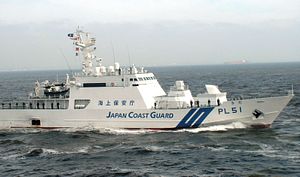The Japanese Coast Guard (JCG), so christened, is a relatively young government entity, turning just 20 next year. Though its predecessor, the Maritime Safety Agency (MSA), was founded in 1948, the JCG is a fundamentally different organization from the MSA. The JCG was only named such in 2000, when it was reorganized under the Ministry of Land, Infrastructure, Transport, and Tourism, and a 2001 revision to the JCG law expanded the JCG’s missions beyond maritime law enforcement and search and rescue at sea.
Since 2001, the JCG’s missions include: patrolling Japan’s territorial seas and exclusive economic zone; countering smuggling and illegal immigration; countering piracy; countering terrorism; conducting surveillance of illegal operations by foreign fishing vessels; acting against suspicious vessels and surveillance ships; dealing with unlawful acts by foreign oceanographic research vessels; firing on noncompliant vessels that ignore warnings; and patrolling and guarding waters near disputed territory, such as the Senkaku/Diaoyu Islands. As Richard Samuels observed as early as 2007, the expansion of the JCG’s mission sets is “the most significant and least heralded Japanese military development since the end of the Cold War.”
Despite not being a military organization, the JCG has been involved in military actions. In 1999, the JCG clashed with a North Korean spy ship off the Noto Peninsula. In this exchange, the JCG requested assistance from the Japanese Maritime Self-Defense Forces (JMSDF), which fired warning shots at the suspected North Korean spy ships. This was the first time Japan had fired warning shots since 1953, and the first time the prime minister requested assistance for the JCG from the JMSDF. In 2001, it was the JCG that “engaged in Japan’s first use of deadly force since the end of World War II, firing in self-defense on an unmarked North Korean spy vessel after the North Korean vessel apparently fired on the JCG vessel using what have been called “military-grade armaments.” The 1999 incident forced Japan to think more seriously about coordination between the JCG and JMSDF, but it was not until 2015 that the JCG and JMSDF began training together in joint civilian-military “gray zone” exercises.
As the JCG will continue to play a role in countering Chinese gray zone activities in the East China Sea, the Japanese government is moving to plug any potential gaps in their defenses, and these include potential technological and informational gaps. On Monday, Nikkei Asian Review reported that the JCG plans to stop using and procuring Chinese-made drones in fiscal year 2020 due to concerns over information security. The JCG has used Chinese-made drones to conduct rescue and surveillance activities. These Chinese-made drones are competitive in price and effectiveness. However, this decision reflects real concerns about private Chinese companies’ subservient relationship to the Chinese state, as well as a desire to remain in lockstep with the United States, which itself banned the purchase and use of Chinese-made drones by the Department of Defense.
Closer to home, the JCG has established a mobile surveillance unit in Ajigasawa, Aomori to respond to the increasing number of drifting wooden boats suspected to be of North Korean origin. The patrol team and liaison office aims to share information with local authorities, and was set up in early November in response to residents’ concerns about the drifting boats. Before the mobile surveillance unit was set up, JCG officers had to drive to the scene from Aomori city, but with the newly instituted daytime patrols, JCG officers can respond more quickly to any sighting. The number of wooden boats found drifting along Aomori Prefecture’s coastline jumped from eight in 2016 to 51 in 2018, leading to increased anxiety among residents.
The JCG really does cover every area of Japan’s national security – geographically from China to North Korea, and functionally from countering threats to reassuring the public. Both the upcoming policy change regarding the use of Chinese-made drones and the creation of the new mobile surveillance unit highlight the multifaceted role the JCG will continue to play in Japan’s defenses.

































